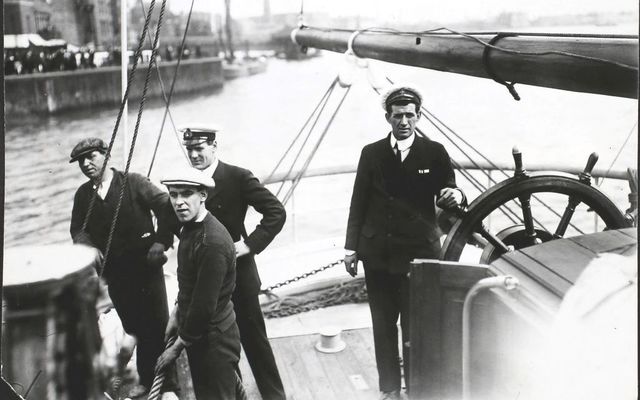Tom Crean completed a dogged 35-mile solo run through the most harrowing of conditions with just three biscuits and two pieces of chocolate in an effort to save the life of his colleague and yet his story is largely forgotten.
We’ve all heard the story of Robert Falcon Scott and his attempt to reach the South Pole for the first time but did you know that accompanying him was one Tom Crean, the son of a Dingle farmer.
While the tragedy of Scott's failure is central in the history of Polar exploration, the Kerry man’s extraordinary achievements during three expeditions to the Antarctic at the start of the last century lay dormant for almost 80 years until the publication of Michael Smith’s "An Unsung Hero: Tom Crean - Antarctic Explorer" in 2000.
Now Tim Foley, author of "Crean: The Extraordinary Life of an Irish Hero," has mounted an online campaign to have the Irishman properly honored. IrishCentral spoke to Foley about his work on the explorer and what can be done to properly celebrate his legacy.
Read more: Hero Irish Antarctic explorer Tom Crean born on this day in 1877
How did your campaign to have Tom Crean recognized begin and did you find that it was easy to convince people to get behind it?
It was in 2010, in a conversation with my brother, that he made mention of a UK airport that had been named in honor of Robin Hood. It seemed an injustice to me that a mythical figure could be offered such an accolade when a man whose incredible heroism was documented on numerous occasions, was only being remembered by a solitary, privately funded statue in the village where he was born.
This conversation spurred me on and the campaign I created started life as a Facebook group with an aim to grow support for the renaming of Kerry Airport in the county of Crean’s birth.
To obtain a wider reach, in 2014, I created the Facebook page with the same aim. Sadly, after an excellent proposal and presentation to the Kerry Airport board, it was, in 2015, turned down.
Later that year I decided to rename the Facebook page Ireland Should Honour Tom Crean and the fan numbers rapidly increased. In nationalizing the campaign it became evident that admirers of Crean stretched across the whole of Ireland and many felt, as I did, that he was worthy of official state recognition.
Fan statistics for the campaign platform confirms that support for the ambition arrives from countries across the world.
In early 2017, I discovered that the Irish Government were seeking to replace the current flagship with a new Multi-Role Vessel that was to have full hospital facilities and would be utilized for humanitarian needs across the globe. The Irish navy has established themselves as world leaders in rescue missions so the planned new flagship was an extension of that purpose. It also happened to be the perfect fit for honoring Crean, a great Irish mariner whose reputation was forged in saving the lives of others.
I created a petition to have the new ship named LÉ Tom Crean and in just over 12 months we had collected over 10,000 signatures from supporters worldwide. Our campaign is truly international and every signatory, should we realize this goal, will have played a vital part. The petition was handed over to the Irish Defence Minister in February 2018 and I recently re-opened it for a second handover when we reach the 20,000 names milestone.
Read more: A 170-year-old mystery of famed Irish Arctic explorer solved
When do you expect to have an answer to the petition?
Ship namings take place traditionally at what is known as the ‘keel laying ceremony’ which signals the beginning of the ship’s construction. As the new MRV is still in the planning stage I’m not privy to the schedule and it could happen at any time in the future but I regularly liaise with the Minister’s office to keep me in the loop and I hope to be among the first to learn about the decision.
I did send the Minister a copy of the book for which he’s thanked me in a recent letter. As I see it, I’m much happier if the man charged with making the decision is familiar with Crean’s incredible story.
Was there any particular feat of Crean's that drove your interest in his life?
It was an article I read in the late 1980s that left me amazed that such a man existed. It was all the better that he was born in Annascaul, a place I knew well as my aunt lived there and I was familiar with the South Pole Inn, the pub that was Crean’s home up until his death in 1938.
The article entitled ‘Polar Crean’, by Denis Barry, chronicled Crean’s tales of heroism and after reading it I was left shocked to discover that he wasn’t better known or celebrated in some way.
People today are becoming more familiar with his name and are mostly aware of his lifesaving solo march for which he was awarded the Albert Medal. As amazing as the solo march was, I can’t separate this from other accounts of his heroism as the factors that brought about my interest.
Overall, there are three separately documented accounts detailing how Crean came to the rescue and his epic feats of bravery were responsible for saving the lives of 28 men.
That translates to a huge number of descendants who today owe their existence to Tom Crean.
Do you think that it has taken Irish attitudes toward those involved with English life to change before he could be remembered?
Yes, it’s a factor that most definitely played a part in Crean’s story remaining buried in the ice of Antarctica for over a century.
The timeline of his career served as the biggest barrier to higher status being afforded him. Joining the Royal Navy, which he did 23 years before the Easter Rising, was for Crean and many other young Irishmen, a means of keeping a roof above their families heads when evictions were commonplace.
Despite misconceptions or thoughts to the contrary, Crean was a dyed-in-the-wool Irishman whose only allegiance was to his country of birth. He spoke the native tongue as his first language and proudly flew the Irish ensign on the back of his sled. He displayed a huge passion for his country and the accounts of others during his time in Antarctica reaffirm his ‘Irishness’ - he regularly attempted his own unique take on ‘The Wearing of the Green’ but reports from those listening confirm his singing talent didn’t match his legendary lifesaving skills.
It has been speculated that Crean ‘kept his head down’ and spoke little of his time in the British Navy because of the political situation on his return to Ireland. I not only believe that to be untrue but I believe such statements serve only to feed the opinion of a small minority who disagree with the aim of providing him national recognition. It was a character trait of Crean’s to actively avoid the spotlight that gave rise to this theory, nothing more.
The truth is that nobody was really aware of Crean’s political beliefs but he proudly stood shoulder to shoulder with his fellow citizens in Tralee while protesting against his former employers in April 1920. Crean was among the throngs of people who traveled to the town after learning that the British government’s treatment of fellow Irishmen in Mountjoy prison had led to one hundred nationalist prisoners going on hunger strike barely one month after his retirement.
Today, the campaign enjoys support from those with beliefs across a wide political spectrum. In the mature, inclusive nation that Ireland now is, the time is perfect to honor a man who fully deserves his place alongside other great Irish heroes.
What is your favorite piece of information about Crean that you discovered over the course of your research?
I think the very essence of the man that I assumed him to be was revealed to me in the passages of a New York Times article I discovered that referred to a lecture given by Teddy Evans, the man whose life Crean saved by undertaking his solo march of 35 miles. Crean’s colleague, Wiliam Lashly, stayed to nurse Evans as Crean set off without skis on soft snow.
Evans, speaking on St Patrick’s Day 1914, to a large audience at New York’s Carnegie Hall, stated the following, as images of Crean and Lashly, were displayed: “They are the men to whom I owe my life and braver, nobler fellows have never lived than they. Crean was Scott’scoxswain on his ship and I am glad to say that he has since been decorated by King George for saving my life.
“When I begged them to leave me, it was Crean who, speaking for both, turned and said to me: ‘If you are to go out sir, then we’ll all go out together.’”
What did you think of previous work on Crean?
Aside from the great piece written by Denis Barry in the 1950s, I have read only Michael Smith’s biography on Crean. His book played a large part in the resurgence of interest in Crean after An Unsung Hero was released in 2000.
Within three years Crean’s solo walk had become the focus of a now iconic Guinness advert and there followed a superb one-man stage portrayal of Tom Crean - Antartic Explorer, by Aidan Dooley which still plays to packed houses today.
In the years that followed, it was left in the main to fan accolades to perpetuate what they knew of his story. Being consigned to tributes in social conversations wasn’t enough - he deserved far greater recognition to match his achievements.
When I decided to research and write my book, world archives had become more accessible and this allowed me to dig much deeper which, in turn, allowed me to transcribe previously undiscovered information and facts about Tom Crean.
The hope now is that those reading his story will support the campaign and help to bring about official state recognition for Crean.
Should we have a national day honoring Crean? What would be the best way to remember him?
Yes, I believe we should and perhaps February 16 revealed as Crean’s birthdate in my book, should be the day that we go that extra mile to help someone in need. Crean did many of those types of miles in his career so It would be a fitting way to celebrate Crean’s Day.
You can find more info on Tom Crean, author Tim Foley, or purchase "Crean: The Extraordinary Life of an Irish Hero" at https://tomcreanbook.com/.
How do you think that Crean should be honored? Let us know in the comments section, below.




Comments